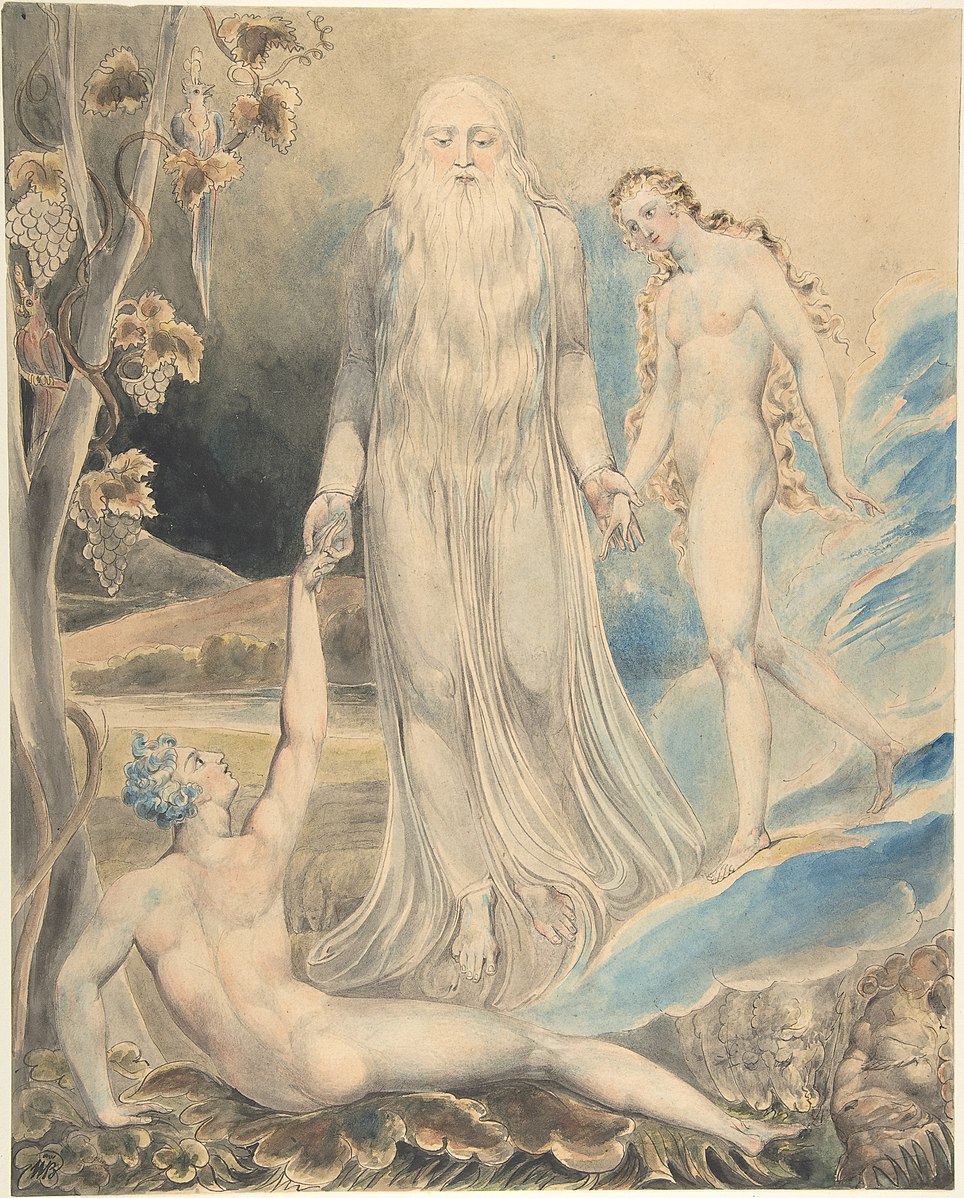The following is the second insatallment of a three-part series. The first can be found here.
Kierkegaard’s Agapic Gift Economy
In his late authorship Kierkegaard articulates the social ontology that has implicitly grounded his previous works, calling for his readership to reassess the site and mode of Kierkegaard’s beginnings, the starting point of existential relation. This starting point mustn’t necessarily be thought metaphysically, theistically, or atheistically, but rather existentially—as a qualified mode of relation to the self and to others. Kierkegaard asserts that, in a sense, we persist in a revolutionary mode insofar as we are called to re/turn to difficult beginnings. He writes,
This is how we are continually turned back to that thought of God’s, the first thought about the human being. In the busy, teeming crowd, which as companionship is both too much and too little, a person grows weary of society; but the cure is not to make the discovery that God’s thought was wrong—no, the cure is simply to learn all over again that first thought, to be conscious of longing for companionship. (emphasis added, WOL 154)
In the face of modernity’s decline and the wounds inflicted by the crowd mentality, we mustn’t despair over sociality, rather, our difficult task is to re/turn to God’s first thought, to learn all over again how to love the other in the proper mode. The properly qualified mode of relation to the other is one that, for Kierkegaard, is a self-annihilating, kenotic economy of love where the individual loves all others infinitely and unpreferentially, earnestly giving everything without expectation or desire for reciprocation.
The kenotic relation to the other is one of radical humility. When one relates to the other, she, at the same moment, relates to God and “ to relate yourself to God, [is] to become nothing” (WOL 103). Moreover, the difficulty of beginnings is componential of the revolutionary mode of Kierkegaard’s agapic gift economy: “this annihilation before God is so blessed that you at every moment would seek to return to this annihilation more intensely” (WOL 103).
For Kierkegaard, the gift economy of kenotic love is more radically revolutionary and far superior to those movements that remain grounded on political economy. The latter remain in the thrall of the finite economy of equal exchange and the worldly categories of public relations that it produces rather than recognizing that alterations in class standing change nothing at all. In a journal entry Kierkegaard writes, “it is very fatuous to want to make the poorer classes impatient with their condition.
The small worldly alteration that may be achieved is nevertheless as nothing” (WOL 415). Instead, he advocates a revolution that re/turns to the difficult beginnings of altering—not the possession of abstract quantities or the level of public esteem one possess—but of transforming how we love, how we relate to others. For Kierkegaard this is far more radical than a reversal of fortune that retains a sense of entitlement and exchange, as is evident in the very offensiveness of what it implies. For what is qualitatively distinct about Kierkegaard’s revolutionary gift economy is its mode of givenness—the emphasis on “how it is given,” how works of love are done, which is directly antithetical to the reciprocal exchange of commerce (WOL 327).
Kierkegaard writes that “love is…sacrifice,” therefore to love earnestly one must give everything, must remain permanently indebted to the other in a mode that is truly without expectation or a sense repayment (WOL 107). Agapic love “is exactly the opposite of a claim…instead of having a claim on which to collect payment, to get a duty to perform…instead of passionately seeking admiration’s luscious fruit” the individual gives all, and “it is by this change that love comes into existence” (WOL 163-164). But when, and only when, one enters into this economy in the properly qualitative mode, she receives an equal return of gracious love.
Kierkegaard explains that God “takes everything, everything, everything—in order to give everything” (WOL 103). He “asks for everything, but as you bring it to him you immediately receive” (WOL 161). But this does not mean that God is a capitalist who seeks to amass your love as equity, with redemption and grace doled out as your wage, rather “God does not ask for anything for himself, although he asks for everything from you” (WOL 161). Kierkegaard makes a subtle distinction here, while the individual’s relation to the other is infinitely asymmetrical, God’s relation to the individual is infinitely symmetrical—this, Kierkegaard terms Christianity’s “like for like, eternity’s like for like” (WOL 376).
The like for like has an echoic structure of re/turn, where works of love that are performed in the proper mode re/turn to the individual. Kierkegaard writes that God is the middle term in an agapic gift economy, one that serves as the qualifying referent to your relations with others:
the Christian like for like belongs to this world of inwardness. It turns itself away and will turn you away from externality (but without taking you out of the world), will turn you upward and inward. In the Christian sense to love people is to love God, and to love God is to love people—what you do unto people, you do unto God, and therefore what you do unto people, God does unto you. (WOL 384)
And here, Kierkegaard proposes a wholly immanent God by implying that God works through our love, simply is the mode of our relations with others: “God is actually himself this like for like, the pure rendition of how you yourself are…God’s relation to a human being is at every moment to infinitize what is in that human being at every moment” (WOL 384). The agapic economy, then, has an echoic structure that re/turns the given in the mode of its givenness: “God just repeats everything you say and do to other people; he repeats it with the magnification of infinity” (WOL 384). But one must listen in the correct existential mode—must actively live in the properly receptive passivity—in order to hear “eternity’s repetition” (WOL 385).
God is the vocative echo of our kenotic love, but one can only hear this re/turn when one maintains the revolutionary posture of perpetual beginnings, where the individual incessantly turns inward, toward the other and away from externality. We must recall that in Ovid’s tale, Echo repeats the voice of Narcissus, but in such a fragmentary manner that it skews and alters signification, the meaning of the original speech act. In much the same way, if the individual is “not in a position to listen properly,” if the relation is performed in the mode of self-love, then “eternity’s repetition” will become fragmented, mis-heard, it will merely be “the noise of life” (WOL 385).
To say that Kierkegaard offers an agapic gift economy as a corrective to the leveling economy of equal exchange and the widespread ills that the latter produces is not without its complications. A lively debate between Jacques Derrida and Jean-Luc Marion continued specifically concerning the paradox of the gift and its relation to an economy of equal exchange. By drawing out the contours of this debate and its central problematic and by reading (particularly Marion) back into Kierkegaard, we can fully appreciate the extent to which the latter employs a fully formed philosophy of the gift. Moreover, Kierkegaard’s corrective already works through and with many of the paradoxes only later identified by Marion. Though Marion’s analysis is conducted phenomenologically, whereas Kierkegaard’s is existential, in many respects Kierkegaard offers the same method of overcoming the gift’s paradoxical reversion to exchange: the reduction to pure givenness.
The Paradox of the Gift
Simply put, the paradoxical nature of the gift that so concerned Derrida and Marion consisted in the idea that, in the process of its actualization or appearance, the gift necessarily reverts to its contrary: exchange. Marion’s intention is to attempt to think the gift outside of “this horizon of exchange and economy,” but for Derrida, this is impossible (GGP 59). Inevitably, it seems, the moment the gift appears, the moment it is received as a gift, it enters into an economy of exchange, thus abolishing its status as gift. Derrida explains: “as soon as the donee knows it is a gift, he already thanks the donator, and cancels the gift. As soon as the donator is conscious of giving, he himself thanks himself and again cancels the gift by re-inscribing it into a circle, an economic circle” (GGP 59).
Which is to say, if the giver of the gift receives self-satisfaction or public esteem in the giving, then “the giver has abolished the gift in favor of exchange…to become the purchaser of his own esteem” (GG 103). On the other hand, when the recipient, the givee, becomes indebted to the giver, or even when she cancels this debt by giving something back, “the givee erases the gift and establishes an exchange in its place” (GG 103). The paradox of the gift is that the moment it enters into the logic of reciprocity it becomes exchange and is therefore abolished as gift; “it loses its status of being given in givenness, appearing instead in its pure and naked market value” (GG 104). Upon its reception, the gift inevitably becomes “endowed with its own exchange value” and is returned “to the commercial circuit” (GG 104).
Once the reception of the gift overshadows its mode of givenness, once it enters into a relation of reciprocity, it becomes an abstraction, appearing in its market value, and is returned to the economy of exchange. To abstract from its mode of givenness, then, is to fetishize the gift, to conceal the conditions of the gift’s givenness. The paradox of the gift, then, is this: “either the gift appears as actual but disappears as gift” by entering the economy of an exchange, “or it remains true to givenness but never appears” as gifted (GG 104). Marion’s corrective, his attempt to extricate the gift from the “horizon of exchange and economy,” is carried out by employing the same remedy Kierkegaard offers in Works of Love, namely, by reducing the gift to its pure mode of kenotic givenness (GGP 59).
The Reduction to Givenness
The paradox of the gift is not a necessary component of the gift as such, but is rather a consequence of our mode of existential relations, one that is firmly entrenched in the leveling effects of the economy of reciprocal exchange. In the modern public we give in the mode of “do ut des [I give so that you will give]” (GG 104). The earnestly kenotic—or as Marion will say, gracious—gift, on the other hand, is given in a mode of radical asymmetry. Rather than assuming a posture of giving that presupposes or desires an equal exchange, the agapic gift is given incognito, is given in a mode of self-sacrifice. Within this mode of relation, “we give without ceasing […] without keeping account, without measure…without a clear consciousness of our giving” (GG 101).
The earnestly kenotic gift of love is given “without keeping account” because it seeks no return; it is given “without ceasing” because, true its revolutionary quality, it perpetually returns to its difficult beginnings and is given “without a clear consciousness of our giving” insofar as it is not an act among others, but is rather a form of life, an existential mode that is wholly embodied and lived. But one must remember that for Marion, perhaps even more so than for Kierkegaard, this is not simply an ideality, but is a mode of relation and givenness that is observable in concrete experience. Interestingly, though Marion reveals pure givenness by engaging in a three-fold reduction of the gift—each one carried out by Kierkegaard in a similar manner—he does not wholly abandon the natural attitude. Rather, pure givenness is potentially experienced in our everyday relations.
Marion provides a number of examples where one or more of the components of the gift economy is already bracketed in virtue of the gift’s mode of givenness or as a result of the gift giving situation. For example, we can imagine a situation like Robinson Crusoe’s, where a gift is received without the givee’s (Crusoe’s) recognition or knowledge of a giver. In this case the giver is bracketed from the gift economy. Also, we can consider a charitable or “humanitarian” gift as one where the givee is bracketed by being unknown to the benefactor. Further, in any situation where one gives a non-objectifiable gift, such as one’s love, forgiveness, or time, the gift itself becomes bracketed in virtue of its inability to be possessed or exchanged. And lastly, Marion argues that the phenomenon of fatherhood is essentially a gift that is observably reduced to pure givenness[1].
We find a parallel series of reductions in Kierkegaard’s Works of Love. Firstly, the kenotic nature of agapic love is such that, when given in the proper mode, it always already brackets the giver. The self-annihilating posture of “loving sacrificially” or indirectly is one where the giver necessarily removes herself from the horizon of an economy of equal exchange (WOL 269). We recall that the agapic gift takes on its full meaning only in “the absence of motive,” when it is given without the desire for “recognition or return;” that is, when “the giver is lacking” by becoming bracketed in the very mode of their giving (GG 114). Secondly, for Kierkegaard, love is neither an object nor a being.
Though it can be symbolized, as in the case of a wedding ring, the object is not love itself. Rather, revolutionary love is a lived condition, a qualitative mode of existence and as such cannot be possessed, re/distributed or exchanged in the manner of political economy. He writes: “love…is not any object” and “cannot…become an object” (WOL 265, 182). With the kenotic gift “no thing is given: when we give time, when we give our life…we give no thing,” rather, we give our self (GGP 63). This means that “the gift does not appear as something [some thing] that could shift from one owner to another owner” (GGP 63). One’s love is not given as one would an object of economic exchange, but as a work of love, and yet this work is not a form of labor, and is therefore not repayable in the form of a wage or material or even symbolic compensation.
This, then, is how agapic love’s qualitative mode of givenness always already brackets the gift itself. Lastly, because Kierkegaard’s sense of love is radically unpreferential, the givee becomes necessarily bracketed as well. Because “every human being is the neighbor,” “to love the neighbor [is] to exist equally for every human being” (WOL 85). Here, Kierkegaard emphasizes that the gift is lived; kenotic love, then, is existential and perpetual, and is never a momentary economic exchange.
Since the relation to the neighbor is radically asymmetrical, and the gift of love is given unpreferentially, without the expectation or desire for reciprocation, its mode of givenness is one where the givee is essentially bracketed. As Marion puts it, “a gracious gift appears precisely because there is no response” (GGP 62). The kenotic work of love, then, as radically asymmetrical: 1) brackets the giver (being given indirectly, even secretively, without desire for return), 2) brackets the gift (insofar as love is not an object or being), and 3) brackets the givee (by being given unpreferentially in an asymmetrical mode of relation). In this way, the work of love is reduced to pure givenness in its very existential mode of being given.
Andrew Ball is associate editor of Screen Bodies and editorial assistant for Communications in Mathematical Physics at Harvard University. He has published in a variety of academic journals such as Religion & Literature, American Literary Realism, and The Journal of Comparative Literature and Aesthetics.
______________________________________________________________________________
[1] Cf. “The Reason of the Gift,” pg. 116-122




